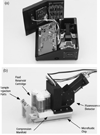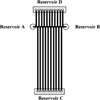Protein separation by capillary gel electrophoresis: a review
- PMID: 22122927
- PMCID: PMC3227876
- DOI: 10.1016/j.aca.2011.10.022
Protein separation by capillary gel electrophoresis: a review
Abstract
Capillary gel electrophoresis (CGE) has been used for protein separation for more than two decades. Due to the technology advancement, current CGE methods are becoming more and more robust and reliable for protein analysis, and some of the methods have been routinely used for the analysis of protein-based pharmaceuticals and quality controls. In light of this progress, we survey 147 papers related to CGE separations of proteins and present an overview of this technology. We first introduce briefly the early development of CGE. We then review the methodology, in which we specifically describe the matrices, coatings, and detection strategies used in CGE. CGE using microfabricated channels and incorporation of CGE with two-dimensional protein separations are also discussed in this section. We finally present a few representative applications of CGE for separating proteins in real-world samples.
Copyright © 2011 Elsevier B.V. All rights reserved.
Figures







Similar articles
-
Chip-capillary hybrid device for automated transfer of sample preseparated by capillary isoelectric focusing to parallel capillary gel electrophoresis for two-dimensional protein separation.Anal Chem. 2012 Aug 21;84(16):7001-7. doi: 10.1021/ac3017168. Epub 2012 Aug 3. Anal Chem. 2012. PMID: 22830584 Free PMC article.
-
Gel and polymer-solution mediated separation of biopolymers by capillary electrophoresis.J Chromatogr Sci. 2003 Oct;41(9):449-59. doi: 10.1093/chromsci/41.9.449. J Chromatogr Sci. 2003. PMID: 14596781
-
Detection of genetically modified maize by the polymerase chain reaction and capillary gel electrophoresis with UV detection and laser-induced fluorescence.J Agric Food Chem. 2002 Feb 27;50(5):1016-21. doi: 10.1021/jf011033g. J Agric Food Chem. 2002. PMID: 11853473
-
Recent progress in chiral separation principles in capillary electrophoresis.Electrophoresis. 2000 Dec;21(18):4112-35. doi: 10.1002/1522-2683(200012)21:18<4112::AID-ELPS4112>3.0.CO;2-T. Electrophoresis. 2000. PMID: 11192127 Review.
-
Recent developments in DNA sequencing by capillary and microdevice electrophoresis.Electrophoresis. 1999 Oct;20(15-16):3066-77. doi: 10.1002/(SICI)1522-2683(19991001)20:15/16<3066::AID-ELPS3066>3.0.CO;2-X. Electrophoresis. 1999. PMID: 10596815 Review.
Cited by
-
Silica colloidal crystals as emerging materials for high-throughput protein electrophoresis.AAPS J. 2013 Oct;15(4):962-9. doi: 10.1208/s12248-013-9506-2. Epub 2013 Jun 26. AAPS J. 2013. PMID: 23800834 Free PMC article.
-
Recent advances in phenolic-protein conjugates: synthesis, characterization, biological activities and potential applications.RSC Adv. 2019 Nov 4;9(61):35825-35840. doi: 10.1039/c9ra07808h. eCollection 2019 Oct 31. RSC Adv. 2019. PMID: 35528080 Free PMC article. Review.
-
Antibody validation for Western blot: By the user, for the user.J Biol Chem. 2020 Jan 24;295(4):926-939. doi: 10.1074/jbc.RA119.010472. Epub 2019 Dec 9. J Biol Chem. 2020. PMID: 31819006 Free PMC article.
-
Combination of strong anion exchange liquid chromatography with microchip capillary electrophoresis sodium dodecyl sulfate for rapid two-dimensional separations of complex protein mixtures.Anal Bioanal Chem. 2022 Feb;414(4):1699-1712. doi: 10.1007/s00216-021-03797-4. Epub 2021 Dec 6. Anal Bioanal Chem. 2022. PMID: 34870722 Free PMC article.
-
Trauma diagnostic-related target proteins and their detection techniques.Expert Rev Mol Med. 2024 Apr 11;26:e7. doi: 10.1017/erm.2024.3. Expert Rev Mol Med. 2024. PMID: 38602081 Free PMC article. Review.
References
-
- Shapiro AL, Vinuela E, Maizel JV. Biochem. Biophys. Res. Commun. 1967;28:815–820. - PubMed
-
- Weber K, Osborn M. J. Biol. Chem. 1969;244:4406–4412. - PubMed
-
- Guttman A, Nolan J. Anal. Biochem. 1994;221:285–289. - PubMed
-
- Shieh PCH, Hoang D, Guttman A, Cooke N, J Chromatogr A. 1994;676:219–226.
-
- Guttman A. TrAC Trends Anal. Chem. 1996;15:194–198.
Publication types
MeSH terms
Substances
Grants and funding
LinkOut - more resources
Full Text Sources
Other Literature Sources

